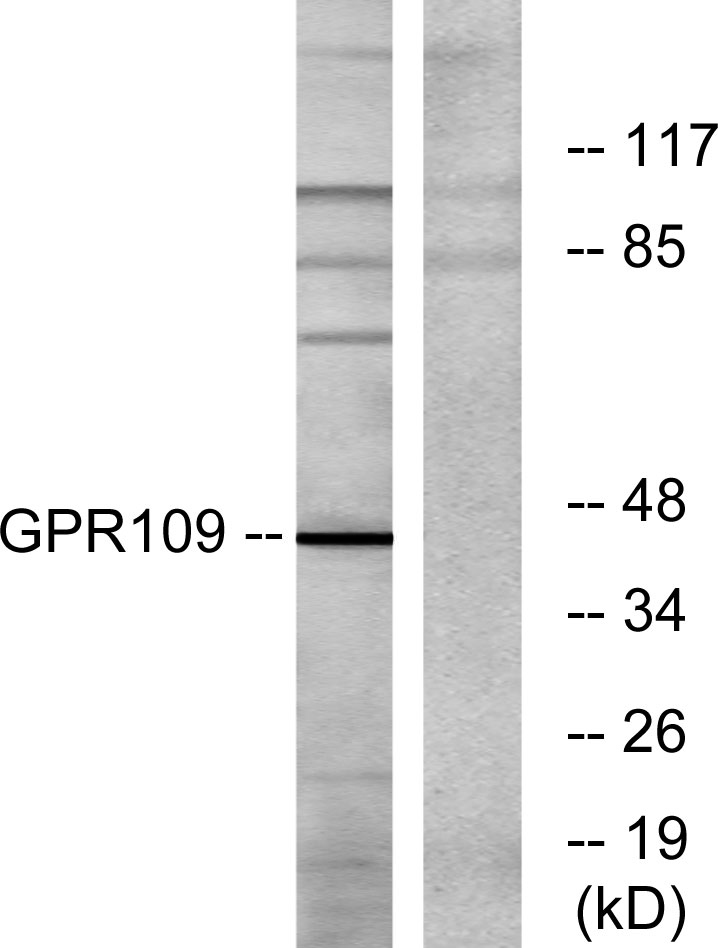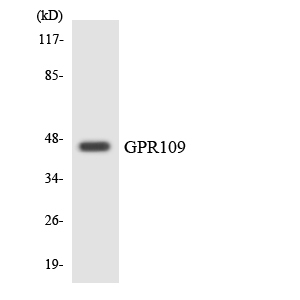HM74 Polyclonal Antibody
- Catalog No.:YT2182
- Applications:WB;IF;ELISA
- Reactivity:Human;Mouse;Rat
- Target:
- HM74
- Fields:
- >>cAMP signaling pathway
- Gene Name:
- HCAR2/HCAR3
- Protein Name:
- HM74A/HM74B
- Human Gene Id:
- 8843/338442
- Human Swiss Prot No:
- P49019/Q8TDS4
- Mouse Gene Id:
- 80885
- Rat Gene Id:
- 353250
- Rat Swiss Prot No:
- Q80Z39
- Immunogen:
- The antiserum was produced against synthesized peptide derived from human GPR109. AA range:285-334
- Specificity:
- HM74 Polyclonal Antibody detects endogenous levels of HM74 protein.
- Formulation:
- Liquid in PBS containing 50% glycerol, 0.5% BSA and 0.02% sodium azide.
- Source:
- Polyclonal, Rabbit,IgG
- Dilution:
- WB 1:500 - 1:2000. IF 1:200 - 1:1000. ELISA: 1:10000. Not yet tested in other applications.
- Purification:
- The antibody was affinity-purified from rabbit antiserum by affinity-chromatography using epitope-specific immunogen.
- Concentration:
- 1 mg/ml
- Storage Stability:
- -15°C to -25°C/1 year(Do not lower than -25°C)
- Other Name:
- HCAR3;GPR109B;HCA3;HM74B;NIACR2;Hydroxycarboxylic acid receptor 3;G-protein coupled receptor 109B;G-protein coupled receptor HM74;G-protein coupled receptor HM74B;Niacin receptor 2;Nicotinic acid receptor 2;HCAR2;GPR109A;HCA2;Hydroxycarboxylic acid receptor 2;
- Observed Band(KD):
- 45kD
- Background:
- developmental stage:Expression in neutrophils occurs in the late terminal differentiation phase.,function:Acts as a high affinity receptor for both nicotinic acid (also known as niacin) and (D)-beta-hydroxybutyrate and mediates increased adiponectin secretion and decreased lipolysis through G(i)-protein-mediated inhibition of adenylyl cyclase. This pharmacological effect requires nicotinic acid doses that are much higher than those provided by a normal diet. Mediates nicotinic acid-induced apoptosis in mature neutrophils. Receptor activation by nicotinic acid results in reduced cAMP levels which may affect activity of cAMP-dependent protein kinase A and phosphorylation of target proteins, leading to neutrophil apoptosis.,miscellaneous:The rank order of potency for the displacement of nicotinic acid binding is 5-methyl pyrazole-3-carboxylic acid = pyridine-3-acetic acid > acifran > 5-methyl nicotinic acid = acipimox >> nicotinuric acid = nicotinamide.,similarity:Belongs to the G-protein coupled receptor 1 family.,tissue specificity:Expression largely restricted to adipose tissue and spleen. Expressed on mature neutrophils but not on immature neutrophils or eosinophils.,
- Function:
- developmental stage:Expression in neutrophils occurs in the late terminal differentiation phase.,function:Acts as a high affinity receptor for both nicotinic acid (also known as niacin) and (D)-beta-hydroxybutyrate and mediates increased adiponectin secretion and decreased lipolysis through G(i)-protein-mediated inhibition of adenylyl cyclase. This pharmacological effect requires nicotinic acid doses that are much higher than those provided by a normal diet. Mediates nicotinic acid-induced apoptosis in mature neutrophils. Receptor activation by nicotinic acid results in reduced cAMP levels which may affect activity of cAMP-dependent protein kinase A and phosphorylation of target proteins, leading to neutrophil apoptosis.,miscellaneous:The rank order of potency for the displacement of nicotinic acid binding is 5-methyl pyrazole-3-carboxylic acid = pyridine-3-acetic acid > acifran > 5-meth
- Subcellular Location:
- Cell membrane; Multi-pass membrane protein.
- Expression:
- Expression largely restricted to adipose tissue and spleen.
- June 19-2018
- WESTERN IMMUNOBLOTTING PROTOCOL
- June 19-2018
- IMMUNOHISTOCHEMISTRY-PARAFFIN PROTOCOL
- June 19-2018
- IMMUNOFLUORESCENCE PROTOCOL
- September 08-2020
- FLOW-CYTOMEYRT-PROTOCOL
- May 20-2022
- Cell-Based ELISA│解您多样本WB检测之困扰
- July 13-2018
- CELL-BASED-ELISA-PROTOCOL-FOR-ACETYL-PROTEIN
- July 13-2018
- CELL-BASED-ELISA-PROTOCOL-FOR-PHOSPHO-PROTEIN
- July 13-2018
- Antibody-FAQs
- Products Images

- Immunofluorescence analysis of MCF7 cells, using GPR109 Antibody. The picture on the right is blocked with the synthesized peptide.

- Western blot analysis of lysates from RAW264.7 cells, using GPR109 Antibody. The lane on the right is blocked with the synthesized peptide.

- Western blot analysis of the lysates from HepG2 cells using GPR109 antibody.



